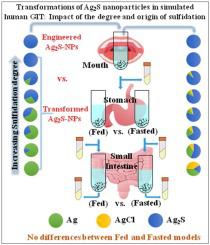Journal of Hazardous Materials ( IF 12.2 ) Pub Date : 2020-07-04 , DOI: 10.1016/j.jhazmat.2020.123406 Ashfeen Ubaid Khan 1 , Zhenlan Xu 2 , Xiaoting Qian 1 , Aimei Hong 1 , Qing Tang 1 , Tao Zeng 3 , Melanie Kah 4 , Lingxiangyu Li 1

|
Engineered silver sulfide nanoparticles (e-Ag2S-NPs) are used in industry and can be released into the environment. Besides e-Ag2S-NPs, transformed silver sulfide nanoparticles (t-Ag2S-NPs) from silver nanoparticles are more likely to be the form that is widely distributed in the environment. Both e-Ag2S-NPs and t-Ag2S-NPs may be ingested and get into human gastrointestinal tract (GIT) through trophic transfer, posing a potential threat to human health. Nevertheless, knowledge of chemical stability of t-Ag2S-NPs and e-Ag2S-NPs in the human GIT is very limited. Herein e-Ag2S-NPs and a series of t-Ag2S-NPs with different degrees of sulfidation were selected as models for exposure to the simulated human GIT including mouth, stomach and small intestine phases under fed and fasted conditions. Silver ions were detected in the simulated saliva, gastric and small intestine fluids when t-Ag2S-NPs or e-Ag2S-NPs were incubated in the simulated GIT, but the amount (e.g., < 20 μg) of silver ion in each phase accounted for < 0.2‰ (w/w) of the silver added (i.e., 100 mg). Silver species of the residual particulate from each phase of the simulated GIT with t-Ag2S-NPs or e-Ag2S-NPs were thus analyzed through a developed analytical method that could selectively, successively and efficiently dissolve and quantify AgCl, Ag(0), and Ag2S in particulates. Both e-Ag2S-NPs and fully sulfidized t-Ag2S-NPs were shown to be highly stable in the simulated human GIT. Conversely, partially sulfidized t-Ag2S-NPs primarily underwent transformations in the mouth phase relative to stomach and small intestine phases regardless of fed or fasted status, wherein AgCl and Ag2S were observed besides Ag(0). The amount of Ag2S in the mouth phase negatively (r = −0.99, p < 0.001) correlated with the sulfidation degree of initial t-Ag2S-NPs. This work improved our understanding of potential transformations of t-Ag2S-NPs in the simulated human GIT, providing valuable information for future researches on evaluating health risks of ingested Ag2S-NPs.
中文翻译:

Ag2S纳米粒子在模拟人体胃肠道中的转化:硫化程度和来源的影响。
工程化的硫化银纳米颗粒(e-Ag 2 S-NPs)在工业中使用,可以释放到环境中。除了e-Ag 2 S-NPs,由银纳米颗粒转化的硫化银纳米颗粒(t-Ag 2 S-NPs)更可能是在环境中广泛分布的形式。e-Ag 2 S-NPs和t-Ag 2 S-NPs均可被摄入并通过营养转移进入人体胃肠道(GIT),对人体健康构成潜在威胁。然而,对人类GIT中t-Ag 2 S-NP和e-Ag 2 S-NP的化学稳定性的了解非常有限。本文中的e-Ag 2 S-NP和一系列t-Ag 2选择具有不同硫化程度的S-NP作为模型,在进食和禁食条件下暴露于模拟的人GIT,包括口腔,胃和小肠阶段。当在模拟GIT中孵育t-Ag 2 S-NP或e-Ag 2 S-NP时,在模拟的唾液,胃和小肠液中检测到银离子,但是银离子的量(例如,<20μg)在每个阶段中,添加的银(即100毫克)占<0.2‰(w / w)。因此,通过开发的分析方法,可以选择性,连续和有效地溶解和定量AgCl,Ag,通过模拟的tIT方法分析具有t-Ag 2 S-NPs或e-Ag 2 S-NPs的模拟GIT各个相中残留颗粒的银物质(0)和Ag 2颗粒中的S。在模拟的人GIT中,e-Ag 2 S-NP和完全硫化的t-Ag 2 S-NP均显示高度稳定。相反地,部分硫化叔银2 S-的NP主要后行变换相对于胃和小肠相口相不论进食或禁食状态的方法,其中氯化银和Ag 2小号被除的Ag(0)进行观察。口腔相中的Ag 2 S含量 与初始t-Ag 2 S-NPs的硫化程度呈负相关(r = -0.99,p <0.001)。这项工作增进了我们对t-Ag 2潜在转化的理解。模拟人类GIT中的S-NPs,为评估摄入的Ag 2 S-NPs的健康风险的未来研究提供了有价值的信息。











































 京公网安备 11010802027423号
京公网安备 11010802027423号